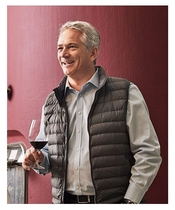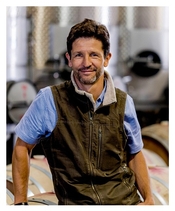Earlier this year I got a message from a PR person offering the opportunity to meet Dan Zepponi who was in town on behalf of  Cuvaison. It had been several years since I had tasted the wines or visited the winery, so I was eager to take advantage of the opportunity. I also recognized his last name, and after confirming that he is the son of Gino Zepponi, I accepted immediately.
Cuvaison. It had been several years since I had tasted the wines or visited the winery, so I was eager to take advantage of the opportunity. I also recognized his last name, and after confirming that he is the son of Gino Zepponi, I accepted immediately.
Dan’s father and Norm Deluze co-founded the ZD Winery in 1979. I met Gino when he was visiting Dallas in the late 1970s. I remember him clearly because he was the first person to identify a wine flaw for me (and the sommelier who was serving our dinner). I was working as the Food and Beverage director for Universal Restaurants, a privately-owned group of four white-tablecloth restaurants in Dallas. That evening we were dining at Arthur’s, a steak house with an all-American wine list, one of only two in the country at that time. The sommelier brought a glass of wine to the table saying something was wrong with it. I agreed that, indeed, there was something wrong, but I couldn’t identify the flaw. Gino took a sniff and said, “it’s corked.” We had not heard that term before, so he explained that the cork had been contaminated by a chemical compound called 2,4,6-Trichloroanisole, a.k.a. TCA, a condition called cork taint. It is not harmful to consume a corked wine, but neither is it pleasant. Gino’s lesson was invaluable.
Dan grew up working at his father’s winery where he learned most of the skills needed to make wine: operating a tractor, pruning vines, filling barrels, running the crusher, conducting lab analysis, etc. He has also developed a wider vision of the wine business as Senior Vice President of Production at Beringer Wine Estates, President of the Mark Anthony Group, President of Vintage Strategies, and President and Partner at West Coast Wine Partners.
I was very impressed with the wines he presented including the Los Carneros, Napa Valley Pinot Noir 2020 ($42), which boasts savory aromas of black cherry, raspberry, dried rose petals promise exciting flavors to come. The promise becomes reality in the mouth with red fruit in the starring role, yet fully integrated with wood spices, vanilla, and notes of dried roses; the wine’s texture is smooth as silk in the mouth.
Winemaker Steven Rogstad says that a dozen different clones of Pinot Noir grown in Cuvaison’s cool-climate Carneros vineyards went into their 2019 Los Carneros, Napa Valley, Pinot Noir ($42). I found delightful, savory aromas mingling with the cherry and blackberry fruit aromas. In the mouth, the wine was very smooth with beautifully integrated red and black fruits mingling with vanilla notes.
The 2020 Los Carneros, Napa Valley, Estate Grown Chardonnay ($30) is a delectable Chardonnay with its aromas and flavors of ripe apples, pears, and citrus intertwined with floral, nutty notes. It is fresh, juicy, and supple in the mouth, balanced with crisp, citrusy acidity. The Estate Grown Los Carneros, Napa Valley Chardonnay 2019 ($30) has ripe, juicy apple, pear, and citrus fruit mingling with wisps of roasted nuts. It is fresh, smooth, and seamless and will continue to develop.
The Estate-Grown Los Carneros, Napa Valley Sauvignon Blanc 2021 ($24) is one of the best I have tasted. It’s not the three percent Sémillon that is the secret ingredient in the wine, but rather the fact that some of the Sauvignon grapes included were of the Musqué clone, which arrived in the U.S. from Bordeaux in 1962. Aromas and flavors of peach, pineapple, guava, and pink grapefruit, with floral honeysuckle notes and vibrant acidity are beautifully integrated.
A couple of months after tasting Cuvaison wines with Dan, I visited Cuvaison and Brandlin where it became clear to me how visionary he is. He has enhanced older, traditional properties with new vineyard plantings, winery modernization and expansion of a beautiful, welcoming tasting room.
A few miles north of the Napa Valley in Lake County is a winery called  Obsidian Ridge, which was created by Michael Terrien, Peter Molnar and Arpad Molnar, a.k.a. Tricycle Wine Partners. They do all the work together, farming the vines, coopering the barrels, and making the wine. Yes, they also make wine barrels of Tokaji oak created by Kádár Hungary, the cooperage owned by the family. Their first vintage was in 2002. They also have Poseidon Vineyard close to the San Francisco Bay.
Obsidian Ridge, which was created by Michael Terrien, Peter Molnar and Arpad Molnar, a.k.a. Tricycle Wine Partners. They do all the work together, farming the vines, coopering the barrels, and making the wine. Yes, they also make wine barrels of Tokaji oak created by Kádár Hungary, the cooperage owned by the family. Their first vintage was in 2002. They also have Poseidon Vineyard close to the San Francisco Bay.
My husband and I visited Arpad in September at the winery, which was in a warehouse complex in the town of Sonoma. It is an ingenious setup—not the usual fancy winery and tasting room. All the tools, tanks, barrels, and other equipment needed to make a high-quality wine.
They make several excellent dry red and white wines, but they also make vermouths, piquettes, a blend of Sauvignon Blanc and pear cider, and pétillant naturel, a.k.a. pet nat. I am particularly fond of the 2021 Pezsgő (pej-guh) Sparkling Pinot Noir with its ripe, juicy Pinot Noir cherry, berry favors dancing with lively acidity. A portion of the proceeds of this wine go toward the company’s "Pezsgő for People" campaign to support Ukrainian refugees.
2022 has been another very informative year learning about wine and the people who make it.
